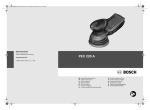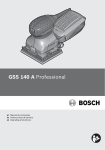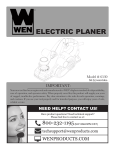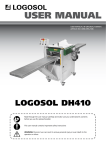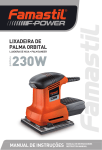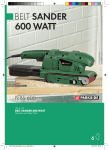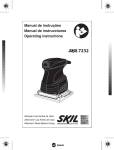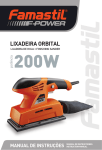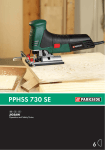Download Kompernass XQ 310 Operating and Safety Instructions
Transcript
Oscillating Sander Before you begin reading this information, please unfold the page with the illustrations and familiarize yourself with all functions of the tool. Oscillating Sander XQ 310 Operating and safety instructions Kompernaß GmbH Burgstraße 21 D-44867 Bochum (Germany) Validity date of the Information: 06 / 2007 · Ident.-No.: XQ 310-062007-1 / UK / IE GB / IE Operating and safety instructions: Page 5 1 2 3 11 10 4 7 5 6 6 9 8 A D B 12 E 7 9 C F Table of contents Introduction Intended use............................................................................................................................... Page Features..................................................................................................................... Page Package contents...................................................................................................... Page Technical data........................................................................................................... Page Safety instructions Safety at the Workplace.......................................................................................... Electrical Safety........................................................................................................ Safety of Personnel................................................................................................... Carefull Handling and Use of Electrical Hand Tools............................................. Appliance-specific Safety Instructions.................................................................... Service....................................................................................................................... Original ancillaries / and accessories.................................................................................. Any questions?.......................................................................................................... Operation Operation.................................................................................................................. Switching On and Off.............................................................................................. Setting the oscillation speed.................................................................................... Attaching a sanding pad......................................................................................... Vacuuming dust......................................................................................................... Instructions, tips and tricks........................................................................................ 6 6 6 7 Page 7 Page 7 Page 8 Page 8 Page 9 Page 9 Page 10 Page 10 Page Page Page Page Page Page 10 10 10 10 10 11 Maintenance and Cleaning...................................................................... Page 11 Disposal. ................................................................................................................... Page 12 Information Service centre........................................................................................................... Page Conformity Declaration /Manufacturer.................................................................. Page 12 12 GB/IE 5 Introduction The following pictogrammes / symbols are used in these operating instructions: n0 V~ w Read the operating instructions! Always wear ear protection, a dust mask, protective gloves, and safety goggles. Always heed warning labels and safety instructions! Always protect the appliance from rain and moisture. Moisture entering into an electrical appliance increases the risk of electrical shock. Caution - Danger of electric shock! Hazardous voltage – danger to life! Safety class II Explosive material! Damaged appliances, power cables and power plugs mean potentially fatal risks from electric shock. Regularly check the condition of the appliance, the power cables and the power plugs. Rated idling speed Keep children and other unauthorised personnel at a safe distance when using electrical tools. Volt (AC) This symbol indicates proper behaviour! Watts (effective power) Dispose packaging and appliance in an environmentally-friendly way! Orbital sander XQ 310 Introduction Before using the appliance for the first time familiarize yourself with all functions of the appliance and inform yourself about the correct handling of electrical tools. Please read the following operating instructions carefully. Retain these instructions for future reference. Additionally, pass them on to whoever might acquire the appliance at a future date. Intended use The oscillating sander is suited for dry sanding of wood, plastics and paints. Any other use or modification is considered improper use and involves significant accident risks. The manufacturer declines to accept responsibility for damage(s) arising out of usage contrary to the instructions specified below. The appliance is not meant for commercial use. 6 GB/IE Features 1 ON / OFF switch 2 Locking button for the ON / OFF switch 3 Release button 4 Dust collection box 5 Adapter (captive) 6 Clamping bars 7 Tensioning lever 8 Sanding plate 9 Sanding Pad 10 Oscillation speed selection 11 Grip surface 12 Reducer Delivery contents 1 Orbital sander XQ 310 15Sanding pads (5 x grit 60 / 120 / 180), see Fig. F 1Dust collection box 1 Reducer, see Fig. D 1 Operating manual 1 Warranty and Service manual Introduction / Safety Instructions Technical Data Nominal voltage: 230 V ~ 50 Hz Nominal power: 310 W Idle speed:n0 6,000 - 11,000 rpm Idle oscillation speed: max. approx. 22,000 rpm Oscillation circle: 2.1 mm Sanding paper size max.:approx. 280 x 115 mm Protection class: II / Information on sound levels and vibration: A-weighted noise level. Sound pressure level: 71 dB(A) Sound power level: 85 dB(A) Weighted acceleration, typical: Hand-arm vibration: 2.149 m / s2 Safety Instructions JImportant! When using electrical tools, the following basic safety measures must be followed to protect against electric shock, injuries and fire hazards. Read and take note of these operating instructions and the safety advice contained therein before using the appliance, and keep them for future reference. Not following the instructions listed below can result in electric shock, fire and / or serious injuries. Safety at the Workplace JKeep working area clean and tidy. Ensure good illumination of the working area. Cluttered and poorly lit working areas can lead to accidents. Explosion hazard! Do not work with the appliance in areas subject to the risk of explosions or in areas where flammable liquids, gases or dusts are located. Electrical hand tools produce sparks which could ignite the dust or vapours. J Keep children and other unauthorised personnel at a safe distance when using electrical hand tools. Should you become distracted, you could lose control over the appliance. J Electrical Safety A void life-threatening electric shocks: J T he power plug of the appliance must match the power socket. Never manipulate the electrical plug. Do not use adapter plugs together with earthingprotected appliances. Unmodified plugs and suitable wall sockets reduce the risk of electric shock. JAvoid physical contact with earthed surfaces, such as pipes, heaters, stoves and refrigerators. There is an increased risk of electrical shock if your body is earthed. J Protect the appliance from rain and moisture. If water or moisture enters into an electrical appliance, the risk of electrical shock increases. JDo not use the power cord for purposes other than intended, e.g. do not use the cord to carry the appliance, for hanging it up or for pulling the plug from the wall socket. Keep the cable away from heat, oil, sharp edges or moving appliance parts. Damaged or tangled cords or plugs increase the risk of an electric shock. J A damaged appliance, power cord or power plug mean a risk of lifethreatening electric shock. Check the condition of the appliance, the power cables and the power plugs on a regular basis. JCheck the power cord of the electric tool on a regular basis and have it replaced by a recognised specialist if damaged. GB/IE 7 Safety Instructions JWhen working outdoors, use only extension cords which are certified for use outdoors. The use of an extension cable suitable for employment outdoors reduces the risk of electrical shock. J Warning! - Never open the appliance. Arrange for repair or component replacement work to be carried out by the service centre or specialists for electrical repairs. Safety of Personnel JAlways be alert and aware of what you are doing. Work sensibly with an electrical hand tool. Do not use the appliance if you are unable to concentrate or tired or under the influence of drugs, alcohol or medication. Just a simple lapse of attention while using an electrical hand tool is sufficient to lead to serious injuries. J Wear personal protective gear and always wear safety goggles. Depending on the use of the electrical appliance, wearing personal protective equipment, such as dust masks, anti-slip safety shoes, protective gloves, safety helmet, and ear protection may reduce the risk of injuries. JAvoid accidental start of the appliance. Ensure the switch is in the "OFF" position before inserting the plug into the power socket. Never touch the ON / OFF switch while carrying the appliance, never switch the appliance on before connecting it to the power supply - this may cause an accident. JDo not overestimate yourself. Ensure you position yourself securely and you are balanced at all times. This allows much better control over the appliance, especially in unexpected situations. JWear suitable clothing. Do not wear loose clothing or jewellery. Keep hair, clothing and gloves away from moving parts. Wear a hair net if you have long hair. Loose clothing and clothing that is not tight against the body, as well as jewellery and hair can be caught by moving parts. JUse dust vacuuming and collecting equipment if these can be attached to the appliance. Please note that the vacuums used must be suitable for this special application. The correct use of 8 GB/IE this equipment reduces risks caused by dust. There is a risk of fire when working with electrical appliances that are equipped with dust bags or which can be connected to an appropriate appliance with a dust suction attachment! Under unfavourable conditions, such as flying sparks, grinding of metal or metal remnants in wood, the wood dust in the dust bag (or in the filter bag of a vacuum cleaner) can ignite. This can happen especially if the wood dust has paint particles on it or is mixed with other chemical substances and the sanded material is hot after extensive working. Therefore, avoid overheating both, the part which is being sanded and the appliance, and always empty the dust bag or the filter bag of the vacuum before work pauses. Carefull Handling and Use of Electrical Hand Tools J D o not overload the appliance. Use the correct electrical tool for your work. With the correct electrical tool, you will work better and more safely within the specified performance range. JNever use an electrical tool with a defective switch. An electrical tool that can no longer be switched on or off is dangerous and must be repaired. J Pull the plug out of the power socket before making adjustments to the appliance, changing accessories or putting away the appliance. These precautionary measures prevent accidental starting of the appliance. JStore unused electrical tools outside the reach of children. Do not allow persons to operate the appliance, if they are not familiar with the use of the tool or if they have not read these instructions. Electrical tools are dangerous if used by inexperienced persons. J Take good care of the appliance. Check whether moving appliance parts are functioning correctly and do not stick, whether parts are broken or damaged and that the functioning of the appliance is not impaired. Have damaged parts repaired before using the appliance. Many Safety Instructions accidents are caused by poorly maintained electrical tools. J Use electrical tools, accessories, aids, etc. in accordance with these instructions and as directed for this special appliance type. Take consideration thereby of the working conditions and the task to be completed. The use of electrical hand tools for purposes other than those originally intended can lead to dangerous situations. Appliance-specific Safety Instructions To avoid the risk of injury or fire as well as health risks: JWhen working outdoors, connect the appliance via a residual current circuit-breaker with a maximum breaking current of 30 mA. JOnly use an extension cord certified for use outdoors. JSecure the workpiece firmly. Use clamps / vices to firmly hold the workpiece. It is thus better secured than just with your hand. JNever support your hands next to or in front of the device or on the surface being worked as there is a risk of injury in the event of slipping. JIn case of danger, immediately pull the power plug from the socket. JAlways run the power cord away from the appliance to the rear. JFire hazard due to flying sparks! When sanding metals, there is a risk of flying sparks. For this reason, always make certain that no one is at risk and that no flammable materials are located near the working area. Jm Warning! Toxic vapours! Working with harmful / toxic dusts results in health hazards for the person operating the appliance and for other persons in the area. Wear safety glasses and a dust protection mask! JWhen working for extended periods on wood and, in particular, materials that produce dusts that are hazardous to health, connect the appliance to an appropriate external suction device. JEnsure sufficient ventilation when working on plastics, paints, lacquers, etc. JDo not soak materials or surfaces to be worked with liquids containing solvents. Heating during sanding can give rise to vapours that are toxic or hazardous to health. JAvoid sanding of lead-based paints or other materials that are hazardous to health. JMaterial containing asbestos may not be worked on. Asbestos is considered a carcinogen. JThe appliance is designed for dry surface sanding of wood, plastic, metal and smoothing compounds as well as painted surfaces. JNever work on moistened materials or wet surfaces. JAlways hold the appliance firmly with two hands while working (see also Fig. D, E). JAlways switch off the appliance and allow the sanding pad 9 to come to a stop before setting down the oscillating sander. JAlways pull the power plug out of the socket for all work pauses, before any work on the appliance (e.g. changing the sanding paper) and when not in use. JThe appliance must always be kept clean, dry and free of oil or lubricating greases. JAlways stay alert! Always pay attention to what you are doing and act with common sense. Never use the appliance when you are distracted or don’t feel well. Service JArrange for your appliance to be repaired only by qualified specialists and only with original spare parts. Thus, you can be certain that the safety of your appliance is assured. JAlways have the plug or power cord replaced by the manufacturer of the appliance or the manufacturer's customer service. Thus, you can be certain that the safety of your appliance is assured. GB/IE 9 Safety Instructions / Operation Original ancillaries / and accessories JOnly use accessories and tools that are specified in the operating instructions. The use of tools and accessories other than those recommended in the operating instructions could lead to an increased risk of personal injury for you. Any questions? JYou may begin the work once you have familiarised yourself with the instructions, functions and handling of the appliance. The safest work is possible by heeding all information and instructions of the manufacturer. Operation Operation Take note of the mains voltage! The voltage must agree with the information on the type plate of the appliance (appliances that are designated as 230 V can also be connected to 220 V). Switching On and Off Switching on intermittent function: jPress the ON / OFF switch 1 . Switching off intermittent function: jRelease the ON / OFF switch 1 . Switching on continuous operation : jPress the ON / OFF switch 1 , hold it pressed and press the locking button 2 . Switching off continuous operation: jPress the ON / OFF switch 1 then release it again. 10 GB/IE Setting the oscillation speed You can set the desired oscillation speed as needed with the oscillation speed selector 10 . The required oscillation speed depends on the material being worked and can be determined through practical tests. Attaching a sanding pad m Warning! Before performing work on the appliance, always disconnect the power. Note: Before attaching a new sanding pad 9 , remove dust and dirt from the sanding plate 8 . 1.Open the two tensioning levers 7 by pushing them up to clamp in a new sanding pad 9 or when switching the sanding pads 9 for the use with different material. 2.Slide the sanding pad 9 at one end under the clamping bar 6 above the sanding plate 8 and clamp it tightly by pressing the tensioning lever 7 back down. 3.Do the same at the other end. Make certain that the sanding pad 9 rests firmly against the sanding plate 8 . See also Fig. B and C. 4.Important! To ensure that vacuuming of dust through the sanding plate 8 is guaranteed, the holes in the sanding pad 9 and the sanding plate 8 must match up. Various materials require different grit values. You can read which grit value is best suited for which work in our recommendations under "Tips and tricks". Vacuuming dust m Warning! Fire hazard! A risk of fire exists when working with electrical appliances that have a dust collection box 4 or can be attached to a vacuum cleaner via an external suction adapter! Under unfavourable conditions, such as flying sparks, grinding of metal or metal remnants in wood, the wood dust in the dust sack (or in the dust bag of a vacuum cleaner) can ignite. This can Operation / Maintenance and Cleaning happen especially if the wood dust has paint particles on it or is mixed with other chemical substances and the sanded material is hot after extensive working. You should therefore avoid overheating of products being sanded as well as the appliance and always empty the dust collection box 4 or the dust bag of the vacuum cleaner before work pauses. Wear a dust mask! Vacuuming dust with the dust collection box Attach the dust collection box j Slide the dust collection box 4 onto the adapter 5 on the rear of the appliance. Remove the dust collection box j Press the release button 3 and pull the dust collection box 4 off the appliance. Note: Always empty the dust collection box 4 in due time and shake any remaining dust out; this will ensure optimal vacuum performance. Attaching the dust removal device to an external vacuum: When using a vacuum cleaner to remove the dust, slide the suction hose of an appropriate vacuum cleaner (e.g. industrial vacuum cleaner) into the adapter 5 – see Fig. D. Note: If necessary, use the reducer 12 and insert it into the adapter 5 . Removing: j Pull the hose from the adapter 5 , or from the reducer 12 , as the case might be. Instructions, tips and tricks jAlways hold the appliance firmly with two hands while working (see also Fig. D, E). jMove the oscillating sander parallel, in flat circles or alternating between lengthwise and side-to-side motions. jDo not press down with the oscillating sander. The sanding pads become clogged, which reduces the sanding performance. jClean the sanding pad 9 occasionally with the vacuum cleaner. jThe removal performance and therefore the result of your work are determined by the correct selection of the speed and sanding pad 9 grit. jNever sand different materials with the same sanding pad 9 (e.g. wood then metal). The following table offers some values, which are for information only and may simplify the selection of a sanding pad 9 . Wood Sanding Pad / Grit Sanding of wood 40 - 240 Pre-sanding, e.g. of rough, unplaned beams and boards 40, 60 Surface sanding 80, 100, 120 Fine sanding of hard woods 180, 240 Paints / Lacquers Sanding Pad / Grit Sanding of paint / lacquer coats or base coats such as filler and smoothing compound 40 - 320 Sanding off paint 40, 60 Sanding off primer coats 80, 100, 120 Final sanding of base coats before painting 180, 240, 320 Maintenance and Cleaning m Warning! Before performing any work on the appliance, disconnect the power plug. jClean the appliance regularly, preferably always immediately after use. jDo not use any sharp objects for cleaning the GB/IE 11 Cleaning and Maintenance / Disposal / Information appliance. Never permit fluids to permeate inside the appliance. jUse a cloth to clean the casing. Never use petrol, solvents or cleansers that damage plastics. A vacuum cleaner is required for thorough cleaning of the appliance. jVentilation openings must never be obstructed. jRemove adhering sanding dust with a brush. Disposal The packaging is made from environmentally-friendly material and can be disposed off at your local recycling plant. Do not dispose of electrical appliances in normal household refuse! Conformity Declaration / Manufacturer We, Kompernaß GmbH, Burgstr. 21, D-44867 Bochum, Germany, hereby declare that this product complies with the requirements of the following EC directives: EC machine guideline (98 / 37 / EG) EC Low Voltage Directive (2006 / 95 / EEG) EMC (Electromagnetic Compatibility) (89 / 336 / EEG), (93 / 68 / EEG) Type / Appliance Designation: Parkside Orbital sander XQ 310 According to European Directive 2002 / 96 / EC for used electrical and electronic appliances and its adoption into national laws, worn-out electrical tools must be collected separately and subjected to an environmentally friendly recycling procedure. Bochum, 30.06.2007 Your local communal or municipal authorities can provide information on how to dispose of the wornout appliance. Hans Kompernaß - Managing Director- Information Service centre Details of the service centre responsible for your country are contained in the warranty documentation. 12 GB/IE Subject to technical changes in the course of further developments.










